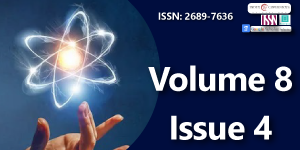Experimental Demonstration of Gravitational Impact on the Speed of Light
Main Article Content
Abstract
Abstract
A cornerstone of Einstein’s special relativity is the postulation that light travels at a constant speed in a vacuum throughout spacetime, independent of the direction, location, time, and photon energy. The constancy and universality of the speed of light play an important role in modern physics for understanding the universe, and their validation has been demonstrated by various experiments and observations. Here we present a laboratory experiment to demonstrate that photons could interact with the Earth's gravitational field and consequently the speed of light would be affected by the Earth's gravity. The experimental results show that the speed of light increases with the gravitational field, and the variation fits with a test model proposed in this work. The findings of this study would open a new research direction on the interaction between photons and the gravitational field and could lead to exploring novel gravito-optic effects and photonics-based gravity detection technologies.
Downloads
Article Details
Copyright (c) 2025 Li E.

This work is licensed under a Creative Commons Attribution 4.0 International License.
Maxwell JC. VIII. A dynamical theory of the electromagnetic field. Philos Trans R Soc London. 1865;155:459-512. Available from: https://doi.org/10.1098/rstl.1865.0008
Einstein A. Zur Elektrodynamik bewegter Körper. Annalen der Physik. 1905;322:891-921. Available from: https://doi.org/10.1002/andp.19053221004
Einstein A. Die Grundlage der allgemeinen Relativitätstheorie. Annalen der Physik. 1916;354:769-822. Available from: https://doi.org/10.1002/andp.19163540702
Serway RA, Moses CJ, Moyer CA. Modern Physics. Cengage Learning; 2004. Available from: https://books.google.co.in/books/about/Modern_Physics.html?id=uTM8AAAAQBAJ&redir_esc=y
Jentschura UD, Adkins GS. Quantum Electrodynamics: Atoms, Lasers And Gravity. World Scientific Publishing Company; 2022. p. 812. Available from: https://doi.org/10.1142/12722
Kovchegov YV, Levin E. Quantum Chromodynamics at High Energy. Cambridge University Press; 2023.
Grossman Y, Nir Y. The Standard Model: From Fundamental Symmetries to Experimental Tests. Princeton University Press; 2023. Available from: https://api.pageplace.de/preview/DT0400.9780691239118_A46419645/preview-9780691239118_A46419645.pdf
Mares JJ, Hubik P, Spicka V, Stavek J, Sestak J, Kristofik J. Shadows over the speed of light. Physica Scripta T. 2012;151:014080. Available from: http://dx.doi.org/10.1088/0031-8949/2012/T151/014080
Grandy D. The Speed of Light: Constancy + Cosmos. Indiana University Press; 2009. p. 216. Available from: https://books.google.co.in/books/about/The_Speed_of_Light.html?id=joKTepFH4WkC&redir_esc=y
Abbott BP, Abbott R, Abbott TD, Abernathy MR, Acernese F, Ackley K, et al. Observation of Gravitational Waves from a Binary Black Hole Merger. Phys Rev Lett. 2016;116:061102. Available from: https://doi.org/10.1103/PhysRevLett.116.061102
Jackson JD. Classical electrodynamics. 2nd edn. Wiley; 1975. Available from: https://www.sciepub.com/reference/409099
Amelino-Camelia G, Ellis J, Mavromatos N, Nanopoulos D, Sarkar S. Tests of quantum gravity from observations of γ-ray bursts. Nature. 1998;393:763-765. Available from: http://dx.doi.org/10.1038/31647
Jacobson T, Liberati S, Mattingly D. A strong astrophysical constraint on the violation of special relativity by quantum gravity. Nature. 2003;424:1019-1021. Available from: https://doi.org/10.1038/nature01882
Jacob U, Piran T. Neutrinos from gamma-ray bursts as a tool to explore quantum-gravity-induced Lorentz violation. Nat Phys. 2007;3:87-90. Available from: https://www.nature.com/articles/nphys506
Abdo AA, Ackermann M, Ajello M, Asano K, Atwood WB, Axelsson M, et al. A limit on the variation of the speed of light arising from quantum gravity effects. Nature. 2009;462:331-334. Available from: https://ui.adsabs.harvard.edu/link_gateway/2009Natur.462..331A/doi:10.1038/nature08574
Addazi A, Alvarez-Muniz J, Batista RA, Amelino-Camelia G, Antonelli V, Arzano M, et al. Quantum gravity phenomenology at the dawn of the multi-messenger era-A review. Prog Part Nucl Phys. 2022;125:103948. Available from: https://ui.adsabs.harvard.edu/link_gateway/2022PrPNP.12503948A/doi:10.1016/j.ppnp.2022.103948
Song H, Ma B. Examining Lorentz invariance violation with three remarkable GRB photons. Phys Dark Universe. 2025;47:101808. Available from: https://doi.org/10.1016/j.dark.2025.101808
Giovannini D, Romero J, Potoček V, Ferenczi G, Speirits F, Barnett SM, et al. Spatially structured photons that travel in free space slower than the speed of light. Science. 2015;347:857-860. Available from: https://doi.org/10.1126/science.aaa3035
Kondakci H, Abouraddy A. Optical space-time wave packets having arbitrary group velocities in free space. Nat Commun. 2019;10:929. Available from: https://doi.org/10.1038/s41467-019-08735-8
Yessenov M, Free J, Chen Z, Johnson EG, Lavery MPJ, Alonso MA, et al. Space-time wave packets localized in all dimensions. Nat Commun. 2022;13:4573. Available from: https://doi.org/10.1038/s41467-022-32240-0
Blandford RD. A century of general relativity: Astrophysics and cosmology. Science. 2015;347:1103-1108. Available from: https://doi.org/10.1126/science.aaa4033
Einstein A. The influence of the force of gravity on the dispersion of light. Annalen der Physik. 1911;340(10):898-908. Available from: https://doi.org/10.1002/andp.19113401005
Pound RV, Rebka GA Jr. Gravitational red-shift in nuclear resonance. Phys Rev Lett. 1959;3:439-441. Available from: https://doi.org/10.1103/PhysRevLett.3.439

